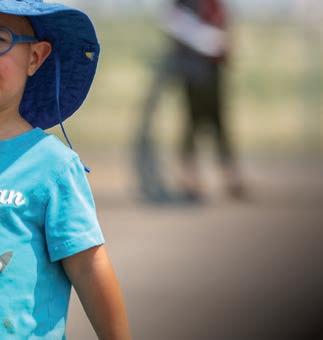
6 minute read
SEE FOOD BANK
bottle-necked supply chain. It means paying more money for less food even as demand rises.
A growing need
According to Todd McPherson, IFCS’s director of development, the nonprofi t distributed over 364,000 pounds of food between January and May of last year. This year, totals are estimated around 406,000 pounds between those same months.
But McPherson said the center needs about 172,000 more pounds to meet current demand. And it is unlikely to get that soon.
Food insecurity is once again on the rise in Arapahoe County and other parts of the metro area.
Between January and May of this year, the food bank is expected to have served more than 27,000 people, with some living as far out as Douglas County and Bailey, according to McPherson. That’s a 111% increase from the same time last year when IFCS served about 24,300 people.
Supplemental Nutrition Assistance Program — or SNAP — users in Arapahoe County have also increased, according to Luc Hatlestad, county spokesperson, who said the county issued 27,218 SNAP benefi ts in March, up from 25,032 in 2021.
SNAP was formerly known as food stamps.
While a surge in federal aid during the fi rst two years of the pandemic helped IFCS meet the needs of thousands coming to its doors, that money is now drying up. McPherson said the nonprofi t is seeing smaller government grants that leave it with less buying power in the face of infl ation.
One of the biggest suppliers of IFCS’s food is wholesale restaurant distributors, such as Sysco, which can provide bulk amounts of a variety of products. The food bank also pays for food from Food Bank of the Rockies, a Feeding America affi liate, as well as from regional farmers.
Spending more for less
Aditi Desai, vice president of marketing and communications for Food Bank of the Rockies, which works with hundreds of distribution partners in Colorado and Wyoming, said the organization spent $1.3 million each month in March and April for food, triple what it spent in 2019 before the pandemic began.
But “just because price is up doesn’t mean we’re not going to purchase it,” Desai said, adding communities need the organization to “keep showing up” for them. The price hikes still trickle down to smaller partners, like IFCS.
For example, the cost for a case of 15 dozen eggs, once $15, has more than tripled to $50, according to McPherson, who purchases the product through Food Bank of the Rockies.
This, coupled with IFCS having to compete for food with other entities — including restaurants and schools — when it orders products means it doesn’t always get what it needs.
It’s frustrating, McPherson said, since IFCS has built a regional reputation as a place to fi nd high-quality, balanced food.
But even shelf items, such as pasta and sauces, are becoming more expensive, said Ashlie Cogburn, who works as a case manager at Arapahoe Community College — which has campuses in Littleton and Castle Rock — and helps oversee the college’s food pantry.
While the college pantry’s supply comes mostly from donations, Cogburn said she was awarded a $4,200 grant in early March to purchase more food and expand the pantry’s locations.
Cogburn said she hoped to use the money on more than just one food order, but infl ation had already raised prices between March and late May, when she ordered the food.
Supply may hamper healthy eating
Joel McClurg, policy and communication manager for Hunger Free Colorado, a food advocacy group, said nutrition security is a vital component of food banks’ work that is threatened when organizations have less food variety.
“Just because somebody’s going to the food bank doesn’t mean they should be getting cheesecake and soda pop,” McClurg said.
Mullins, who frequents IFCS once a week, said having fresher produce is “night and day” when it comes to his health and said “when I eat healthy, you can feel it.”
Mullins receives federal food aid through SNAP. Under the Biden administration, average benefi ts were boosted by 25% to $157 per month for an individual, up from $121 before the pandemic.
But as infl ation continues to worsen, the extra dollars haven’t been enough to cover everything Mullins would usually buy at a grocery store, such as meat.
Brenda Hallman, who lives in Denver and frequents IFCS every other week, said she has had to cut down on her grocery shopping as food and gas prices eat away at her limited income.
“I don’t buy meat at the grocery store. I just get the essentials, bread, milk, eggs, stuff like that,” said Hallman, who, along with her husband, lives on a fi xed income, bringing in about $24,000 between both of them.
Solutions look large and small
Cogburn, the ACC case manager, said the college is looking at boosting the maximum allotment for King Soopers gift cards it distributes to eligible students.
Over the past two years, the college has pumped out more than $7,500 to students in gift cards, with the maximum on a card per semester being $80. But that is far from what is needed to cover basic grocery costs, said Cogburn, who said she spent nearly $200 on just three bags of groceries during a recent shop.
“The conversations are happening, but with infl ation the way it is they’ll never happen fast enough,” Cogburn said of the college’s efforts to increase its aid.
It’s a palpable concern for many, according to McClurg.
With SNAP benefi ts being stretched thin to cover basic food costs, McClurg said he wants the federal government to authorize a temporary boost to accommodate for infl ation. But relief will also come at the local level, McClurg said, with communities needing to continue to support food banks.
Donations, McPherson said, are crucial for IFCS’ ability to weather the current economic upheaval.
“People have the power to grow and donate,” McPherson said.
People can donate to IFCS by going to ifcs.org/donate or by texting BetterTogether to 801801. The nonprofi t also accepts donations for non-food items, which can be critical for people needing toiletries and other supplies not covered by SNAP.
DOLLAR DAY DAD’S DOLLAR DAY DAD’S
ONLY $1
JUNE 19TH 12PM - 5PM
Celebrate Father’s Day at Wings Over the Rockies! All dads will receive $1.00 admission at both locations.
Smart security. Professionally installed.



Protection starts with prevention

Know When People and Packages Arrive Peace of Mind Starts Here

Get FREE Professional Installation and Four FREE Months of Monitoring Service*
Use Promo Code 4FREE

